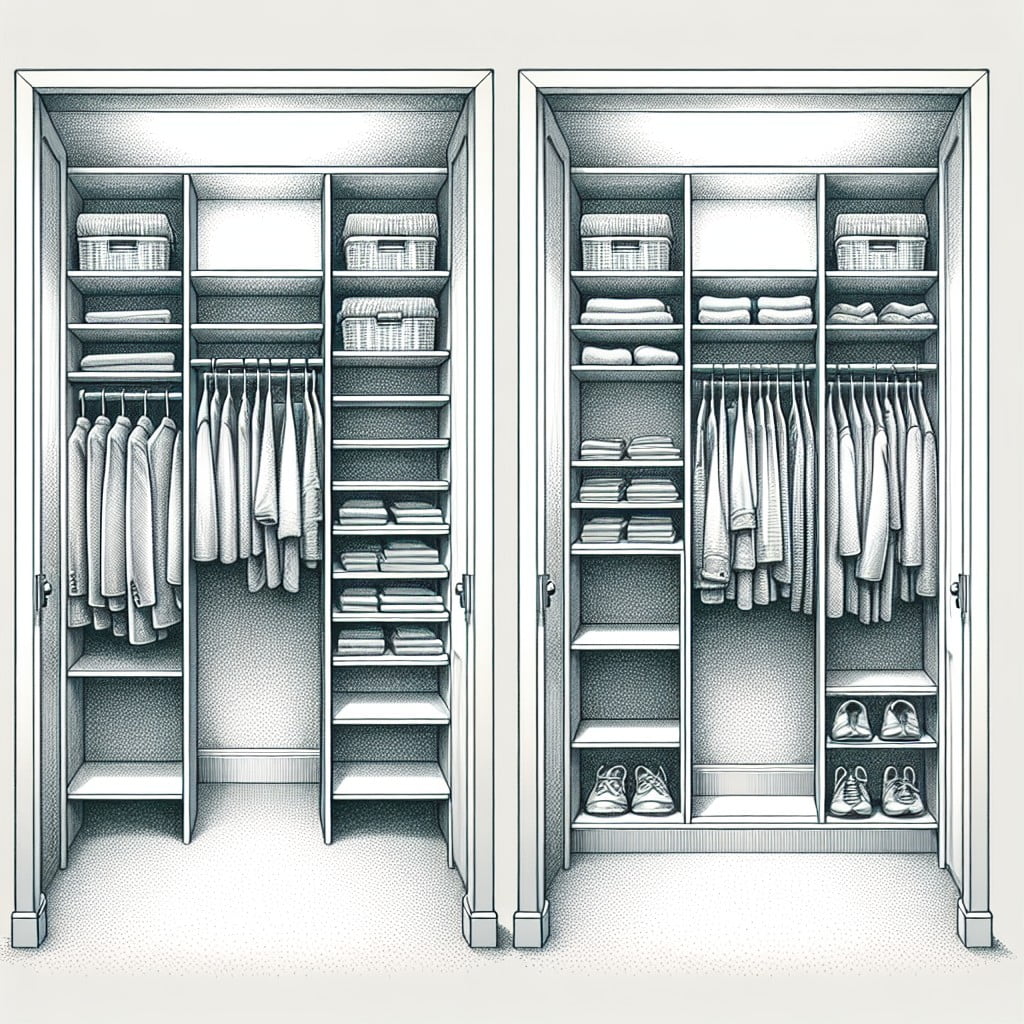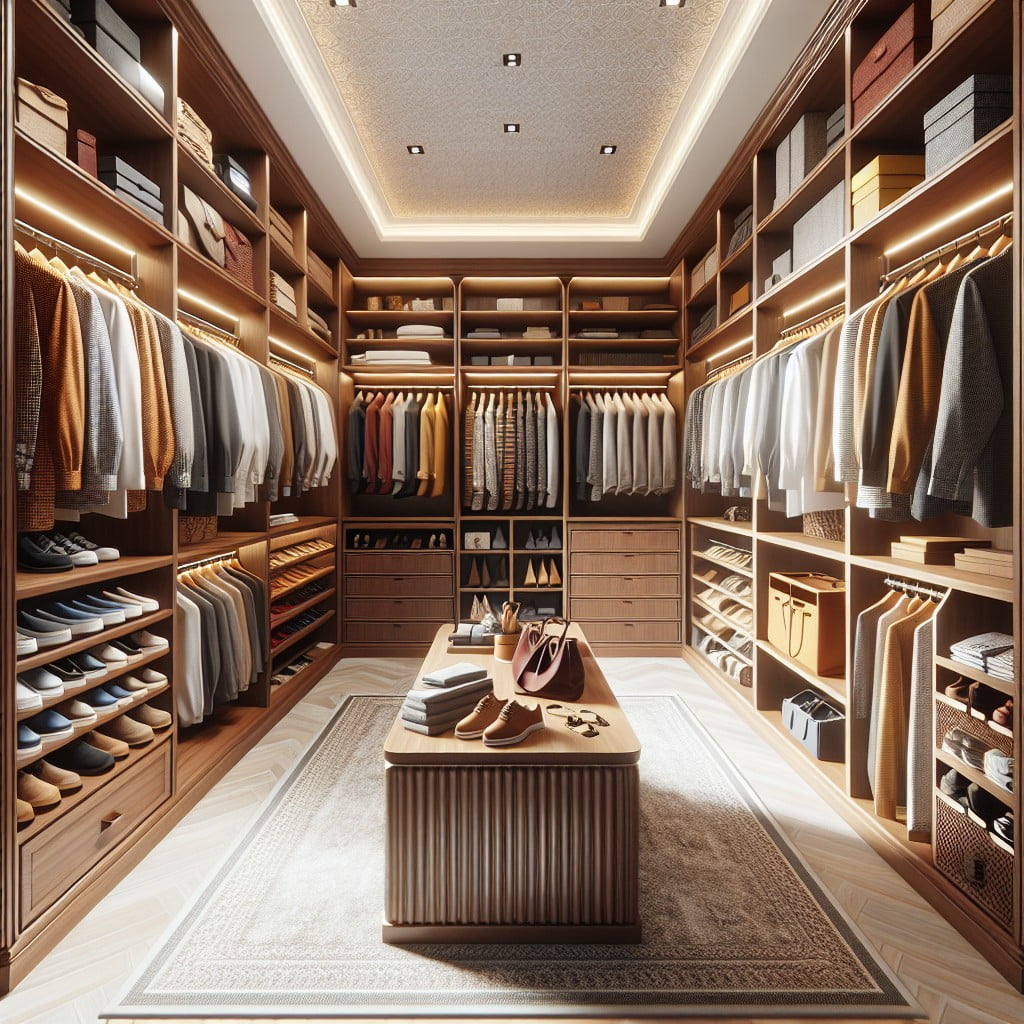Last updated on
Your dream of organizing your attire seamlessly can become a reality with the correct walk-in closet size, because an optimal design can transform your daily dressing routine into a pleasurable experience.
When envisioning an ideal home, many imagine a spacious walk-in closet where clothing, shoes, and accessories are neatly organized and easily accessible. Whether you’re remodeling or building from scratch, understanding the optimal size for a walk-in closet can transform your storage space from cluttered to curated.
This article delves into the nuances of different walk-in closet layouts, from the classic straight design to sophisticated island-centered arrangements, and uncovers the essential measurements needed to create a practical and inviting space. With actionable tips on designing your own walk-in closet, and insights on hanging space, shelf dimensions, and drawer organization, you’ll be equipped with all the knowledge necessary to design a closet that not only fits your inventory but enhances your daily dressing ritual.
Let’s help you tailor your perfect walk-in closet, where every inch is crafted with intention.
Key takeaways:
- Different Types of Walk-in Closet Layouts: Straight, L-Shaped, U-Shaped, Island
- Determining the Measurements for Your Walk-in Closet: Length, Width, Height, Clear Walkway
- Tips to Follow While Designing Your Own Walk-in Closet: Inventory, Vertical Space, Lighting, Flexibility, Materials, Accessibility, Professional Help
- Hanging Space Considerations: Rod Height, Length, Materials
- Shelves and Drawers: Shelf Depth, Drawer Dimensions, Shelf Spacing
Different Types of Walk-in Closet Layouts

Selecting the right layout is crucial to maximize space and functionality. Here are the common configurations:
- Straight Layout: Ideal for narrow spaces, this design features storage units on one side, offering a straightforward approach.
- L-Shaped Layout: This configuration utilizes two walls, providing ample storage while still maintaining floor space for dressing.
- U-Shaped Layout: Surrounding the user on three sides, this layout maximizes storage and organizational options in larger walk-ins.
- Island Layout: Reserved for spacious closets, an island provides additional drawer space and a flat surface, often used for folding or displaying items.
Each layout can be tailored to individual needs, focusing on storage preferences, space constraints, and personal style. Incorporating the right mix of hanging areas, shelves, and drawers ensures a walk-in closet that’s both efficient and enjoyable to use.
Determining the Measurements for Your Walk-in Closet

Before taking any steps toward construction or renovation, precise measurements are the foundation of a well-designed walk-in closet. Start by measuring the room’s length, width, and height, as these dimensions will dictate the layout options and storage solutions available. Account for door swing space and ensure a minimum of 24 inches of clear walkway for comfortable movement around the space.
Remember to consider the specific needs of the closet’s primary user. For example, a height of 84 inches is standard for hanging rods and shelves, but this may require adjustment to match the individual’s reach. Additionally, the depth of the closet should be at least 24 inches to accommodate hanging clothes without them touching the back wall.
Evaluate the types of items to be stored, as this will influence the design. Will it predominantly feature hanging space, or do you need more shelves and drawers for folded garments and accessories? This information will help in calculating the optimal distribution of space and storage components within the closet.
Lastly, leave flexibility for future adjustments within your measurements. Consider adjustable shelving or modular components that allow changes as storage needs evolve, ensuring lasting functionality of the walk-in closet.
Tips to Follow While Designing Your Own Walk-in Closet
When designing your walk-in closet, keep in mind the following aspects to maximize functionality and aesthetics:
- Assess your inventory: Take stock of your wardrobe and belongings to ensure your closet caters to your storage needs.
- Optimize vertical space: Utilize the full height of your closet with high shelves for seldom-used items and lower, accessible areas for daily essentials.
- Consider lighting: Good lighting is crucial; aim for a combination of natural light and high-quality, color-accurate artificial lights.
- Incorporate flexibility: Adjustable shelves and rods allow you to adapt the space as your needs change over time.
- Choose the right materials: The materials should match your home’s style and be durable enough to withstand daily use.
- Plan for accessibility: Ensure that your layout allows easy access to items. Keep daily items at arm’s length and less frequently used items higher or lower in the closet.
- Involve a professional: If possible, consult with a design expert or organizer for personalized advice tailored to your space and requirements.
Hanging Space Considerations: Rod Height, Length, and Materials
When planning hanging space, balance is crucial. Position rods for long garments, like dresses and overcoats, at a height of at least 60 inches to prevent them from touching the floor. For shorter items such as shirts and skirts, rods mounted around 42 inches high optimize space and accessibility. Double-hanging rods can greatly increase capacity—with upper rods typically at 80 inches and the lower at 40 inches for easy reach.
Choosing the length of your hanging rods depends on the collection size. Allocate at least 1 inch of rod space per item for breathing room, preventing wrinkles and ensuring easy selection. For materials, metal rods are durable and provide a sleek look, while wooden ones offer a warm, classic aesthetic. Both should support the weight of heavy garments without bending, so check load capacities when selecting.
Remember to theorize accessibility points for all hanging items, keeping daily outfits within easy reach and seasonal wear stored higher or towards the back. High-quality hardware attachments will ensure longevity and smooth operation—a desirable trait in the hustle of daily wardrobe choices.
Shelves and Drawers: Shelf Depth, Drawer Dimensions, and Shelf Spacing
For optimal use of space, shelf depth should range from 12 to 16 inches. This allows for easy access to items without wasting space. Adjust the height between shelves based on the items you’re storing – typically, 10-12 inches for folded clothes and up to 15 inches for handbags or shoes.
When planning drawers, aim for a width of 24 to 36 inches with a depth of at least 14 inches, ensuring adequate room for clothes without excessive reach. For ease of use, install full-extension drawer slides that allow you to view the entire drawer contents.
Remember to leave enough clearance between the shelves and drawers for easy opening and viewing; a minimum of 24 inches of walkway space is recommended. Choosing adjustable shelving can provide the flexibility to adapt your closet system to your changing needs over time.
Closet Organization Tips: Categorize, Color-coordinate, and Seasonal Rotation
Maximize the functionality of your walk-in closet by orchestrating its contents with strategic organization techniques. Implementing a categorization system ensures that items are grouped logically, such as keeping all outerwear in one area and evening wear in another. This simplifies finding what you need and helps maintain order.
For an aesthetically pleasing arrangement, consider color coordination. Not only does this create a visually satisfying environment, but it also assists in quickly identifying clothing by hue, further expediting your selection process.
Incorporate seasonal rotation into your organization plan by storing out-of-season clothing in the less accessible areas of your closet. This method keeps your wardrobe manageable, with the most current and frequently used items within easy reach. Transitioning to such a system will streamline your daily routine and optimize your closet space.
Ideal Walk-In Closet Dimensions: Small, Single-sided, Double-sided, and Island Dimensions
When it comes to selecting the perfect size for a walk-in closet, you’ll want to balance space for storage with enough room to move comfortably. Here’s what to consider for each type:
- Small Walk-In Closets: Typically, these spaces measure at least 4 by 4 feet and accommodate a single wall of storage. To optimize space, use multifunctional storage systems.
- Single-Sided Walk-In Closets: A step up in size, these require a minimum width of 5 to 6 feet. With storage on one side, the opposite side offers ample room for movement and dressing.
- Double-Sided Walk-In Closets: To fit storage solutions on both sides, plan for at least 7 feet in width. This ensures there’s enough aisle space to browse and access items without hassle.
- Walk-Ins with Islands: For an added luxury of a center island, your closet should be no less than 10 by 10 feet. Islands are excellent for extra drawer space and a flat surface for folding or organizing.
Remember, these dimensions are guidelines. Tailoring your walk-in closet to your individual storage needs and space can yield the most satisfying results.
Creating a Functional Design for Your Walk-in Closet
A functional walk-in closet design maximizes space while maintaining ease of access to your items. Here are key points to consider:
1. Zone Planning: Designate specific areas for types of clothing and accessories. Place daily-wear items at eye level and less frequently used items higher up or towards the bottom.
2. Clearance Space: Ensure there’s enough room for doors to swing open or drawers to pull out without obstruction, typically 24-36 inches.
3. Lighting: Opt for bright, diffused lighting that illuminates all sections of the closet without causing glare.
4. Versatility: Adjustable shelving and modular components allow for customization as your wardrobe changes over time.
5. Ergonomics: Install rods, hooks, and shelves at heights that are comfortable to reach, reducing the need to strain or use step stools.
6. Visibility: Glass doors on cabinets and good lighting can help you see and pick out items quickly, saving time during your routine.
7. Ventilation: To prevent clothes from smelling musty, consider a closet design that allows for airflow or includes a small ventilation system.
Incorporating these elements ensures that your walk-in closet is not only aesthetically pleasing but also practical and adaptable to your lifestyle.
Walk-in Closet Ideas for Storage Capabilities and Designs
Implement a variety of hanging areas to accommodate different clothing lengths—double rods for shirts and pants, and single rods for dresses and coats.
Incorporate shelves at varying heights; higher shelves for less frequently used items, and eye-level shelves for everyday wear.
Add drawers with clear fronts or labels to easily identify contents without the need to rummage.
Consider pull-out baskets for bulkier items like sweaters or accessories, which can keep them neatly stored and accessible.
Integrate specialty storage solutions such as tie racks, belt loops, or jewelry drawers to keep small items organized.
Use adjustable shelving and rod systems that can adapt to your changing wardrobe needs.
For footwear, slanted shelves or cubbies can display your shoes while making them easy to find and pair.
Maximize vertical space with overhead compartments to store out-of-season clothing or luggage.
If space permits, introduce a seating area or an island with built-in drawers for additional storage and a place to lay out outfits.
FAQ
What is a good size for a walk-in closet?
A standard walk-in closet should ideally measure a minimum of 6.5 feet in both width and depth to guarantee comfort and functionality.
Is 5×5 big enough for a walk-in closet?
Yes, a 5×5 space is sufficient for a small walk-in closet, although maximizing storage capacity with thoughtful additions is recommended.
Is 4 wide enough for a walk-in closet?
Yes, a 4-foot width is sufficient for a functional walk-in closet, but for hanging options on both sides or including built-ins, a width of 6 to 7 feet is recommended.
What size is a small U shaped walk-in closet?
A small U-shaped walk-in closet typically has a minimum width of 7 feet (approximately 2.13 meters), with overall closet depths commonly ranging around 5 to 6 feet (approximately 1.52 to 1.83 meters) for efficiency.
How does the size of a walk-in closet impact the overall home value?
The size of a walk-in closet can significantly impact the overall home value as larger closets often increase property appeal and functionality, boding well for resale value.
What is the recommended size for a luxury walk-in closet?
A luxury walk-in closet is ideally sized at approximately 100 square feet or more.
Can a 6×6 feet space work efficiently as a walk-in closet?
Yes, a 6×6 feet space can work efficiently as a walk-in closet if effectively organized.
Liked reading this? Here’s more:
Recap:


